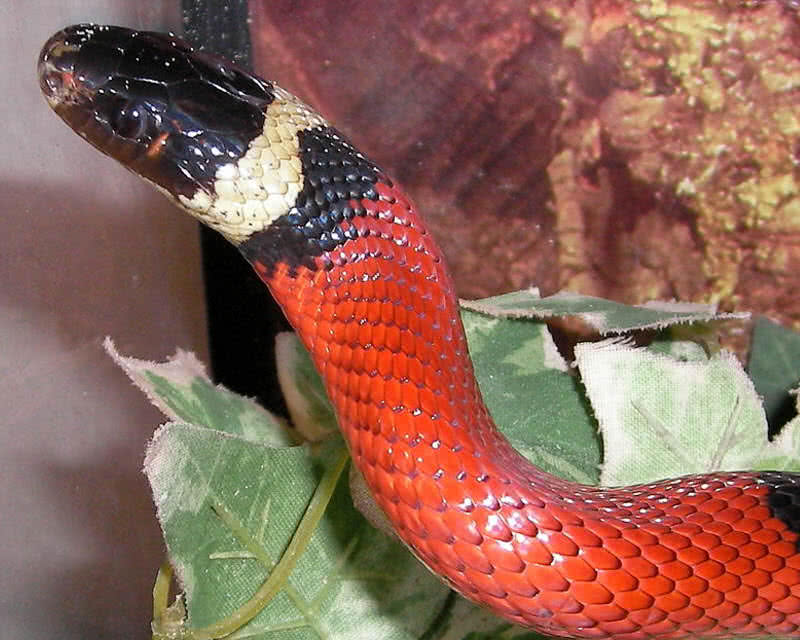

They are generally more slender and are round in cross section. Triangulum), and sometimes Northern Copperheads ( Agkistrodon contortrixīlack (except under the chin) with smooth scales on the dorsal side. guttata), Eastern Milksnakes ( Lampropeltis t. Often confused with Northern Black Racers ( Coluber c. Over 2.5 feet, but can be retained much longer. Normally, the pattern begins to become obscure and darken in individuals Of the head, extending from the eye to the posterior jaw. There is also a distinct brown or black stripe on each side Juveniles exhibit a strong pattern consisting of 28 to 40 dark brown or blackĭorsal blotches on a uniformly gray background (Mitchell, 1994). Showing evidence of the blotched pattern characteristic of juveniles (Conant andīright white in the throat and neck region, yielding to mottled black and whiteĬheckers along the midbelly.
#Adult black milksnake skin
Red, yellow, or white areas of skin appear between the scales, often Anal plate is divided.īodies of adults are generally black on the dorsal side. In cross section, the bodies of ratsnakes are not round, but insteadĭorsal scales are weakly keeled, while the lateral scales are smooth.

Specimens have been known to exceed 8 feet in length. Individuals normally reach an adult size of 4 to 6 feet however, It is considered to be the state’s largest serpent. Some text fragments are auto parsed from Wikipedia.One of the most common snakes found in West Virginia. This proximity to barns, and therefore cows, probably gave rise to the myth. Milk snakes are, however, frequently found in and around barns, making use of their cool and dark environments, and for the easily accessed populations of rodents to feed on. The myth is entirely false, and is discredited by the fact that the milk snake does not have the physical capabilities to suck milk out of a cow. They are nocturnal eaters and are often found during the day in old barns and under wood.Īn early myth about milk snakes is that they suck cow udders to get the milk. Nevertheless, the diet of an adult milk snake still primarily consists of rodents. They have been known to consume a variety of animals including rodents, eggs, birds, reptiles, amphibians, and invertebrates. Milk snakes are much more opportunistic eaters than the fox snake or corn snake. They are also known to eat birds and their eggs, frogs, fish, and other snakes. Young milk snakes typically eat slugs, insects, crickets, and earthworms.Īdult diet frequently includes lizards, and small mammals.

⤷ Atlantic Central American milk snake, ''L. ⤷ Pacific Central American milk snake, ''L. Listed alphabetically by subspecific name. ⤷ ''Osceola doliata triangula'' - Cope, 1900 ⤷ ''Coronella triangulum'' - Boulenger, 1894 ⤷ ''Lampropeltis triangula'' - Cope, 1860
#Adult black milksnake Patch
Eastern milk snakes also have a light colored v-shaped or y-shaped patch on their neck. There is enough distinction among the five to make the Eastern milk snake fairly easy to identify. Juvenile milk snakes, which are more reddish than adults, are often killed because they are mistaken for copperheads. Milk, fox, and scarlet snakes are killed because of a resemblance to the venomous rattlesnake. However, the Eastern milk snake does not resemble a coral snake instead it tends to have similar markings to that of several other snakes, particularly the fox snake, scarlet snake and most importantly, the massasauga. ⟶ *Red touches black, you're OK, Jack red touches yellow, you're a dead fellow. While both milk snakes and coral snakes possess transverse bands of red, black and yellow, common mnemonics can be used to properly distinguish between the deadly coral snake and the harmless milk snake: Some milk snakes have a striking resemblance to coral snakes and this mimicry likely scares away potential predators. However, red blotches instead of bands are seen in some populations. They have smooth and shiny scales and their typical color pattern is alternating bands of red-black-yellow or white-black-red.


 0 kommentar(er)
0 kommentar(er)
